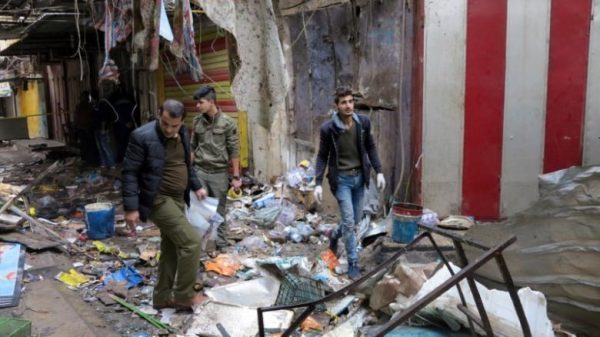
Three bombs killed 29 people in Baghdad on Saturday as fighting intensified in the northern city of Mosul, where Iraqi government forces are trying to rout Islamic State militants from their last major stronghold in the country.
Blasts, including one suicide attack, tore through a busy market in the Sinak neighborhood, police said. A pro-Islamic State news agency said the target was Shi’ite Muslims, whom the militants regard as apostates.
A third blast later in the day killed four people in the eastern New Baghdad district, where a minibus packed with explosives blew up in a busy commercial street, police and medics said.
Islamic State has continued to launch attacks in the heavily fortified capital, even after losing most of the northern and western territory it seized in 2014.
The recapture of Mosul would probably spell the end for Islamic State’s self-styled caliphate, but the militants would still be capable of fighting a guerrilla-style insurgency in Iraq, and plotting or inspiring attacks on the West.
The second phase of a U.S.-backed offensive launched on Thursday following weeks of deadlock has encountered fierce resistance. Conventional U.S. forces deploying more extensively in this phase are now visible very close to the front lines.
The third day of the renewed push saw heavy clashes on the southeastern and northern fronts.
An army officer deployed in the southeast said there was fierce fighting on the edge of Intisar district on Saturday and advances were slowed by heavy machine gun fire, snipers and rockets attacks by militants entrenched in houses.
The officer said Islamic State fighters were firing from houses with white flags raised over the roofs, falsely indicating they are civilians to avoid being targeted by Iraqi forces and coalition airstrikes.
“The more we advance the tougher it becomes. The job of differentiating between fake and real houses with civilians inside is becoming more painful to our troops,” he told Reuters by phone.
BATTLE FOR MOSUL
An elite Interior Ministry unit continued to push on Saturday through the Intisar district, where a U.S.-trained army unit had struggled to advance far after entering the southeast district last month.
Heavy gunfire was audible and attack helicopters fired overhead as hundreds of civilians fled their homes, a Reuters cameraman said.
In the north, a separate army unit pressed towards the border of Mosul proper after recapturing several outlying villages in the past two days.
“There is a battle in Argoob area, which is considered the gateway to Hadba,” Lieutenant Colonel Abbas al-Azawi said by phone, referring to a strategic northern neighborhood.
Since the offensive began on Oct. 17, elite forces have retaken a quarter of Mosul in the biggest ground operation there since the 2003 U.S.-led invasion that toppled Saddam Hussein. Prime Minister Haider al-Abadi has said the group would be driven out of Iraq by April.
Although the militants are vastly outnumbered, they have embedded themselves among Mosul residents, hindering Iraqi forces who are trying to avoid civilian casualties. Despite food and water shortages, most civilians have stayed in their homes rather than fleeing as had been expected.
One resident reached by phone late on Friday said a rocket had landed on a house in the eastern Mithaq district, killing six members of one family.
“We have not seen Daesh since the Iraqi forces restarted their offensive,” he told Reuters. “We hear the sounds of large car bombs. Today I heard no fewer than 10 huge explosions.”
REUTERS
Leave a Reply
You must be logged in to post a comment.